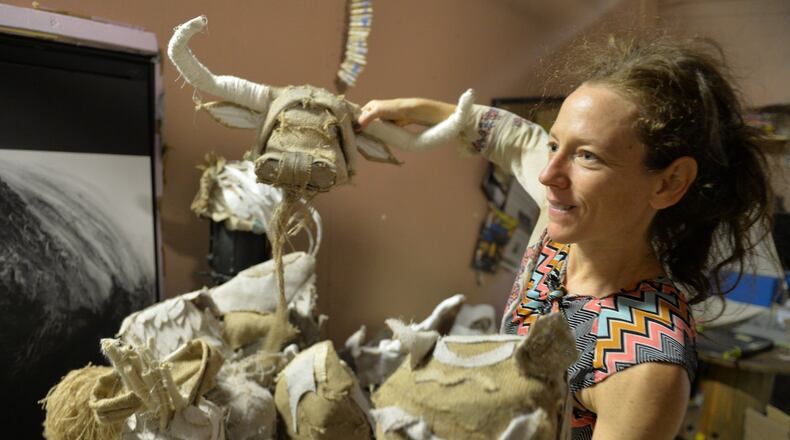EVENT PREVIEW
"Cloth." A multimedia collaboration between Robert Spano, Glo and Micah and Whitney Stansell. 8:30 p.m., Sept. 10-14. $10-$75. Goat Farm Arts Center, 1200 Foster St. N.W., West Midtown. http://tanzfarm.com/
Lauri Stallings flings an arm, as if shaking off a cobweb, while her pale, muscled leg spears into the air behind her, her foot planting, her body turning.
It is cool in the dark interior of the former factory space, even though it is 92 degrees outside and warm air and bolts of light pour in through the barn-size doors. A troupe of six dancers watches Stallings’ movements carefully, then attempts to replicate them.
“Turn, diagonal, back, back, yeah, yeah,” Stallings coaches her coterie. “The stillness is always there,” she reminds them. “It doesn’t have to be captured.”
On a Tuesday afternoon the six women, part of the experimental dance corps Glo, are shaping the movements that will be part of a major collaboration called “Cloth.”
The multimedia event will combine music, dance, film and sculpture in a customized environment built inside a cavernous 19th-century factory building at the West Midtown venue known as the Goat Farm Arts Center.
Among the collaborators is Robert Spano, music director of the Atlanta Symphony Orchestra, whose music is the axis around which everything turns. Spano will play a 23-minute solo piano work he wrote for “Cloth,” as well as a two-piano version of Stravinsky’s “The Rite of Spring,” in which he will be joined by Bosnian keyboardist Pedja Muzijevic and a percussion ensemble led by ASO principal percussionist Tom Sherwood.
Video from filmmakers Micah and Whitney Stansell will be projected on a panoramic screen that surrounds the audience, while sculptures from artist Audrey Morrison, who also contributed animal-head masks for the dancers, will float in the air.
It is a marvelous, massive, coordinated art happening. There’s only one problem: It’s not quite done.
For a month Spano has been writing the 13 sections of “Cloth.” Like “The Rite of Spring” it is a suite of separate parts. Stallings visited Spano with her iPad as he completed each short chapter, and recorded him performing that section, then took it back to her dancers.
Two weeks before opening night, Spano was still scribbling furiously. “I’m feeling the heat right now,” he said, just before rehearsal on Tuesday. And the Stansells were still shooting footage, including an upcoming outing in Vinings that was to incorporate horses.
Meanwhile, Stallings has been putting her own stamp on the Stravinsky ballet, which famously freaked out audiences when Vaslav Nijinsky first staged the radical new work 101 years ago in Paris. “I spent three hours translating 50 seconds of music for the dancers yesterday,” she said during a break in the Tuesday preparations, as her sweaty dancers took a moment to gasp for air.
In the same room a roaring scissor lift hoisted trusses up to the building’s ancient beams, in preparation for Dave Balliet’s lighting design.
Performances are Sept. 10-14 and will include “Cloth” and “The Tower,” which is what Stallings calls her reworking of “The Rite of Spring.”
As he watched the preparations, Goat Farm co-owner Chris Melhouse described the stage design, which will consist of concentric ovals surrounding the in-the-round performance space. At floor level will be a corral of chairs that he designed and built, intended to allow the observer to lean back, planetarium-style. Above and behind that, more custom seating will be on a raised platform, and above that, a ribbon of screen will wrap around the audience like a cyclorama.
The new chairs, still unfinished wooden skeletons in need of padding, were scattered around the room. “It came from her head,” said Melhouse, referring to Stallings. “I just facilitated what she thinks she wants.”
Stallings and Spano first worked together on “Maa,” a 2011 multimedia collaboration staged at Symphony Hall, and each has great confidence in the other. “On the second night of that work, he took me aside and said ‘We’re doing ‘Rite of Spring’,’” said Stallings.
Glo typically performs in unconventional settings — at MARTA stations, in Howard Finster’s Paradise Garden, in Maddox Pool, at Lenox Mall and in the streets of Atlanta and Roswell.
And once again, the performance space figures heavily in the production.
“When Lauri first took me to the Goat Farm, I got excited to write music for that space,” said Spano. “The space is so inspiring.”
And the prospect of wearing an animal head while he plays?
“I’m not sure of that,” said Spano. “She hasn’t ruled that out.”
About the Author
The Latest
Featured



